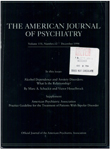Oculomotor performance in obsessive-compulsive disorder
Abstract
OBJECTIVE: Neuroimaging studies have shown abnormalities of the frontal cortex and basal ganglia in persons with obsessive-compulsive disorder. Since lesions in the frontal cortex and basal ganglia areas affect performance on goal-guided saccadic eye movements, this study investigated the relation between the diagnosis of obsessive-compulsive disorder and oculomotor performance. METHOD: Eleven patients with the clinical diagnosis of obsessive-compulsive disorder and 14 normal subjects were assessed with respect to their performance on both visual- guided and goal-guided oculomotor tasks. Fixation performance was also measured. RESULTS: The group with obsessive-compulsive disorder had a very significantly greater error rate and a significantly greater rate of inaccurate saccades on the goal-guided antisaccade task, whereas they were not different from the normal group in reaction time, saccadic velocity, and accuracy on the visual-guided saccade task. The distribution of error rates for the patients with obsessive-compulsive disorder was broad, with more than one-half outside the range of the normal group. Most of the abnormal findings were among male patients. CONCLUSIONS: The results support the hypothesis of a relationship between impaired performance on goal-guided saccadic eye movement tasks and the diagnosis of obsessive-compulsive disorder, but they also suggest a gender-related subgroup within the group with obsessive- compulsive disorder.
Access content
To read the fulltext, please use one of the options below to sign in or purchase access.- Personal login
- Institutional Login
- Sign in via OpenAthens
- Register for access
-
Please login/register if you wish to pair your device and check access availability.
Not a subscriber?
PsychiatryOnline subscription options offer access to the DSM-5 library, books, journals, CME, and patient resources. This all-in-one virtual library provides psychiatrists and mental health professionals with key resources for diagnosis, treatment, research, and professional development.
Need more help? PsychiatryOnline Customer Service may be reached by emailing [email protected] or by calling 800-368-5777 (in the U.S.) or 703-907-7322 (outside the U.S.).



